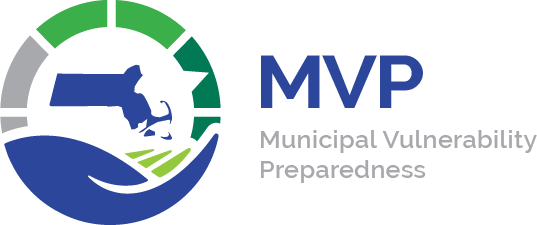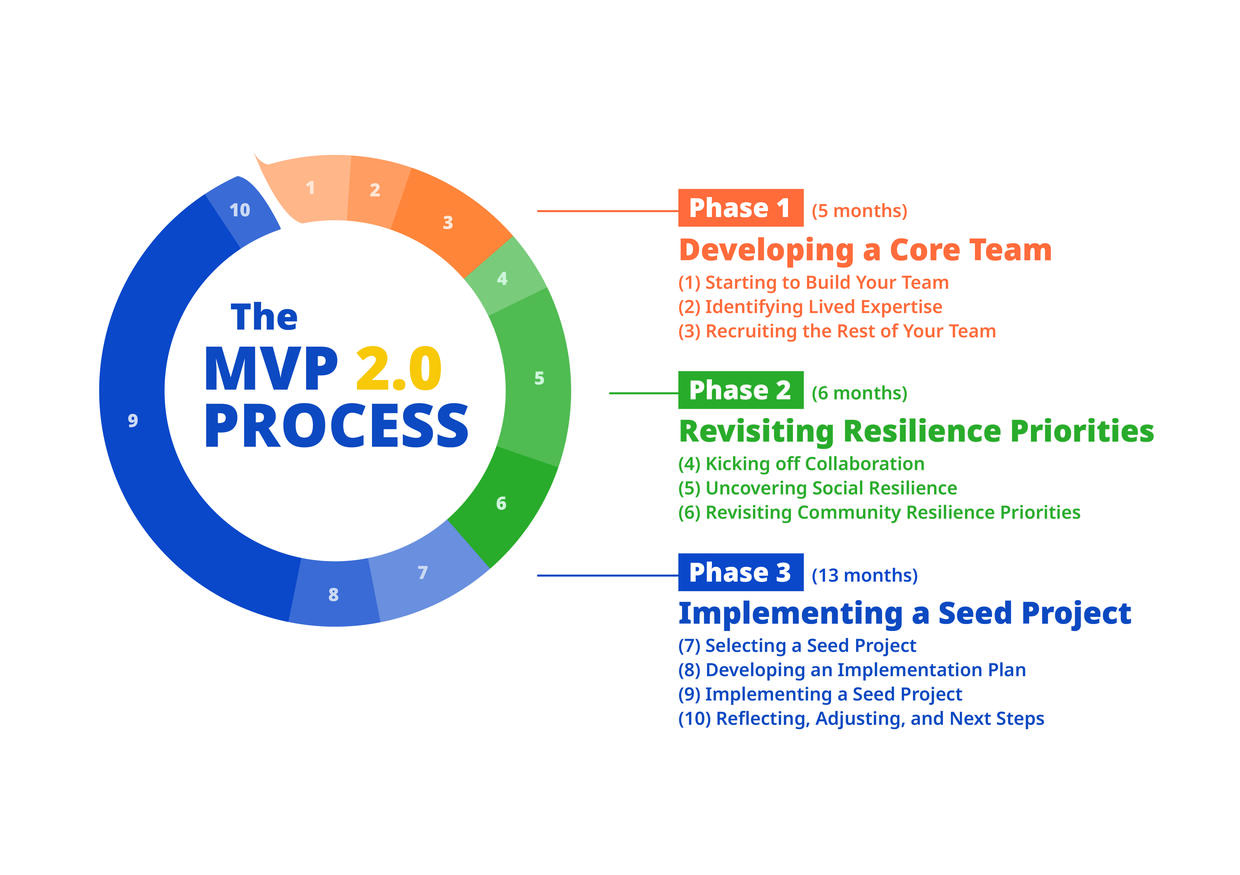MVP Planning 2.0 Overview
MVP 2.0 supports communities with new processes, tools, and resources for building resilience. It fills gaps from the original MVP planning process (MVP 1.0), and builds on the work communities have done to date.
Through MVP 2.0, communities can revisit resilience priorities with a focus on equity and translate those priorities into action through project development and implementation. This updated program has a greater focus on building social resilience and explores the factors that create vulnerability or resilience for people living or working in your community. The process will focus on connecting and collaborating with community members, and expanding the voices involved in climate resilience efforts.
MVP 2.0 is designed to be completed over two years, knowing that it takes time to build new relationships, expand the involvement of the broader community, and work together to develop and implement a project.
Watch the video to hear how current MVP 2.0 core team members have been engaging with their communities. Or view the whole MVP 2.0 video series to learn how the MVP program is evolving to help communities integrate equity into their climate resilience planning and translate priorities into local action.
Current MVP 2.0 Communities and Awards
- The FY25 round of MVP 2.0 is underway with 23 municipalities and three regional groups, representing another 10 municipalities. Learn more about the FY25 round of participating communities.
- EEA is currently piloting the program with 32 communities and 1 tribe through FY24-25. Learn more about participating pilot communities. Thank you to all the participating communities and vendors who have provided feedback and helped to make the program stronger for the upcoming round.
How is MVP 2.0 different from MVP 1.0?
How is MVP 2.0 different from MVP 1.0?
- MVP 2.0 is not a traditional planning process! You will revisit your resilience priorities, but MVP 2.0 does not involve producing or updating a plan.
- MVP 2.0 expands community involvement. The process focuses on input from the broader community and specifically people who will be most impacted by climate change.
- MVP 2.0 dives deeper into social resilience. The process and tools help identify root causes of social vulnerability and what it will take to build community resilience.
- MVP 2.0 focuses on translating priorities into action. The grant provides guidance, tools, and guaranteed funding to complete a resilience project.
- MVP 2.0 trains a community team. In doing so, the expertise stays within the community.
MVP 2.0 Process
The MVP 2.0 Planning Process Guide provides complete instructions on how to lead your community through the process. Process steps and support tools are summarized below.
Three guidance documents walk through the process in full. These include:
- The MVP 2.0 Process Guide provides detailed instructions on how to lead your community through the process. This document is intended for the Municipal Project Manager and your Planning Vendor who will help lead the process.
- The MVP 2.0 Process Summary provides a summarized version of the MVP 2.0 process. This document is designed for your Core Team members.
- The MVP 2.0 Roadmap breaks down the process activity-by-activity and outlines the estimated time each step will take and the roles and responsibilities of the project partners. This id designed to be a blueprint for the Municipal Project Manager, Planning Vendor, and Equity Partner to coordinate around project tasks.
(Step 1) Starting to Build Your Team
Every awardee is paired with an Equity Partner right from the start. The Equity Partner helps provide coaching and guidance on things like inclusive engagement and how to measure the equity impacts of projects. The Equity Partners are hired by the State directly (awardees will not be responsible for paying the Equity Partners). Shortly after being notified of receipt of an MVP 2.0 Grant, awardees will coordinate a meeting with their Equity Partner and MVP Regional Coordinator to kick-off the process and to proceed with building your team.
In Step 1, building your team will include selecting and hiring a Planning Vendor, and recruiting municipal staff for your Core Team. The Core Team will have approximately ten people, including municipal staff and Community Liaisons (people with strong connections to populations most likely to be impacted by climate hazards). For communities without paid staff, “municipal staff” may include community members who often play a municipal staff-type role. There is a collection of Resources for Hiring a Planning Vendor to help with this step. There is also a draft Email and Position Description to support recruiting municipal Core Team members.
(Step 2) Identifying Lived Expertise
In Step 2, the municipal Core Team members, with support from their Equity Partner and Planning Vendor, will use the Community Exploration to identify the lived expertise and perspectives that will be important to include on your Core Team. This step sets the stage to expand the involvement of the wider community in climate resilience planning, specifically to make sure that the priorities of people who will be most affected by climate change shape decisions. The GEAR Community Guide can help explore who lives in the community. By the end of Step 2, you will have a sense of the types of experiences and perspectives you will be looking for when recruiting Community Liaisons.
(Step 3) Recruiting the Rest of Your Team
In Step 3, municipal Core Team members will recruit Community Liaisons to join the Core Team. There are Resources for Core Team Recruitment to help with reaching out to Community Liaisons. There is also a working database of community-based organizations around the state which can support this step. Your team’s Equity Partner will help onboard the team, and make sure everyone has the support they need to participate in the process. Step 3 will result in a list of confirmed Core Team members.
(Step 4) Kicking off Collaboration
In Step 4, the Core Team will complete a couple of team-building activities facilitated by your Planning Vendor and Equity Partner. The goal is to learn more about the MVP 2.0 process, learn about each other, and to build a foundation for working together as a team. As part of these activities, the Core Team will watch the MVP 2.0 Kickoff Videos and complete the Discussion Guide.
(Step 5) Uncovering Social Resilience
Step 5 is focused on identifying factors that contribute to vulnerability and resilience for people who live and work in the community. The data and information collected in this step will provide key insight for approaching a Seed Project and future Action Grants. Core Teams will use GEAR to investigate data related to community vulnerability and resilience, develop an Engagement Plan for connecting with a range of community members, conduct outreach and engagement activities to gather insight from the community, and document their findings related to social vulnerability and resilience in the Social Resilience Roadmap. Your Equity Partner will also lead two learning sessions during this step – one focused on social vulnerability and climate equity in your community, and one focused on building skills for inclusive engagement.
(Step 6) Resetting Resilience Priorities
Step 6 focuses on revisiting and updating your community’s resilience priorities (from MVP 1.0), based on progress to date and new information that you have gathered in Step 5. This step provides a moment to make sure that your community resilience priorities reflect what was heard from EJ and other priority populations in the community or region. The Core Team will use the Resilience Priorities Guide to update your priorities and then will reach out to the community to gather feedback. The Engagement Plan provides support for developing an approach for vetting updated community resilience priorities with the community.
(Step 7) Selecting a Seed Project
In Step 7, the Core Team will develop one to three ideas for a Seed Project and will vet the project ideas with the community. A Seed Project is a project selected by the Core Team that will jump-start or advance the community’s resilience priorities, and that can be completed in 9-10 months. Communities will receive $50,000 of guaranteed funding to complete a Seed Project with no local match required. Core Teams will be able to draw on inspiration from the Municipal Climate Resilience Playbook (coming spring 2025) as well as the GEAR guides, which provide actions to consider and case studies. By the end of this step, the Core Team will have completed the Seed Project Plan (Part A) to select a Seed Project.
(Step 8) Developing an Implementation Plan
Core Teams will build out an implementation plan for the Seed Project, including mapping out the project’s goals, key partners, tasks, deliverables, timeline, budget, and metrics of success. The implementation plan will be captured in the Seed Project Plan (Part B). The MVP 2.0 grant includes funds to support a Subject Matter Advisor(s) who can help advise on the development of the implementation plan. In some instances, your Subject Matter Advisor may become the vendor that implements the project. At the end of Step 8, your Planning Vendor will submit the MVP 2.0 Interim Submission Form. This step wraps up the scope for your Planning Vendor.
(Step 9) Implementing the Seed Project
Before starting Step 9, Core Teams will contract with an Implementation Vendor. The expertise of the Implementation Vendor will depend on the Seed Project. Step 9 then involves implementing the Seed Project, which should take approximately nine to ten months to complete. For many communities, implementation of a Seed Project will provide the groundwork for future Action Grants.
(Step 10) Reflecting, Adjusting, and Next Steps
In the final step, the Core Team will reflect on the process, noting what went well, what was learned, and how you might improve your process for future resilience building efforts. The Core Team will document the reflection in the Reflection Guide. To close out the MVP 2.0 process, the Core Team submits the MVP 2.0 Final Submission Form with completed deliverables, documentation of spent funds, as well as photos and other documentation related to the Seed Project.
Guides for Equitable & Actionable Resilience (“GEAR”)
New with MVP 2.0, Guides for Equitable & Actionable Resilience (GEAR) supports communities as they explore community resilience and vulnerability. Users can pair a climate hazard (e.g., heat) with a community system (e.g., housing) to learn about key issues at the intersection of these factors. GEAR provides a series of questions to further explore the topic in a given community or region, as well as case studies and considerations for taking action.

